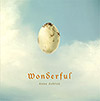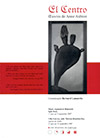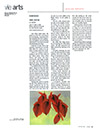home art cv / bio texts elements contact français
texts
|
Wonderful |
|
El Centro : œuvres de Anne Ashton |
|
|
Anne Ashton: El Centro |
artist's statement
Since 1992, my artistic practice has explored the interconnection of natural forms, systems and cycles. Over time, the idea of interconnection has also influenced the way I create and assemble my paintings in multi-paneled polyptychs or installations. In this way, the visual and conceptual interaction between each aspect of the work imitates natural systems composed of disparate yet interdependent elements. The polyptychs are sometimes accompanied by found objects or by words and images painted directly on the walls of the exhibition space. Through my art, I attempt to evoke the spectator’s own sense of connection – with the artwork, with art in general, but especially with the natural world that surrounds us and to which we belong.
Born in California, I have lived and worked in Quebec for more than 25 years. Concepts remain central to my practice due to the influence of 1970s West Coast Conceptualism during my university studies. However, to fully illustrate an idea, I scrounge from a range of art historical and scientific sources as well as pop culture. In spite of their apparent simplicity, the resulting paintings are layered with formal and cultural references including Hyperrealism, Surrealism and Luminism; cosmology, music, folklore and myth. Many of the chosen subjects reveal my affection for things considered dangerous or lacking inherent beauty. Others echo the transitory and ephemeral cycles of nature. The gathering of these disparate elements into one large piece underlines the singularity as well as the interdependence of each component. In the current global context, it is important to consider nature’s beauty and vulnerability as well as the interdependence of all species, including our own.
backstory
My first complete sentence, according to my mother, was “See the bug”. My outlook has not changed much since then. My entire artistic practice is a variation on this theme.
My artwork is inspired by the strange and unpredictable beauty of nature, including those elements often dismissed as menacing or useless. It depicts the natural world in many manifestations: sensual and ominous, serene and raging, mysterious and vulnerable. It explores the cyclical transformation between these states, and the interconnection of each element within a complex system.
My painting process is like a road trip full of detours, roadblocks and unexpected surprises. The end results are unplanned. I often feel like a vehicle, a channel into something bigger than myself. A close friend calls this “talking to the gods”, and I have never found a better description of the creative process.
Often, a grouping of many paintings is needed to fully illustrate the original idea. At other times the subject requires visual footnotes, and this additional imagery is painted on a border, or the edges of the painting, or the walls. Likewise, I am interested in what is found on life's edges and peripheries, across the border, under the rocks and on the outskirts of town.
Not long ago my partner and I watched a spider spin a web in the moonlight outside an anonymous bar in the Ottawa valley. Comparing our human accomplishments to the spider's craft, he said, “We are nothing”, and I shared his humble feelings. Painting enables me to sense nature more deeply, to see individual peculiarities and merits within a vast, interdependent system. It helps me to find my own place in this world, and to appreciate the spider as much as the moonlit sky.
© Anne Ashton 2011-2022


